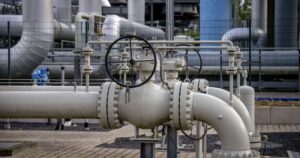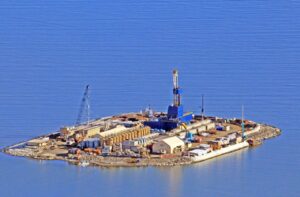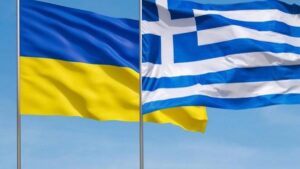
The Cabinet of Ministers of Ukraine has maintained zero quotas for the export of natural gas of Ukrainian origin in 2026, according to Government Resolution No. 1795 of December 31 on the list of goods whose export and import are subject to licensing and quotas.
According to the document, exports of natural gas of Ukrainian origin in 2026 will continue to be subject to quotas, with the quota set at zero.
The resolution is published on the government’s website.

The vast majority of European countries in 2022-2024, before President Donald Trump returned to the US presidency in January 2025, bought much more oil and gas from Russia than they provided support to Ukraine, said US Deputy Secretary of State Christopher Landau.
“I knew that many of these countries had tied their energy fortunes to Russia, but I had no idea of the scale of this or how much (collectively) it overshadowed their aid to Ukraine,” he wrote on social media on Saturday.
Landau illustrated his post with a chart provided to him by the US State Department. He specified that he had requested this data in connection with his trip this week to a meeting of NATO foreign ministers, replacing Secretary of State Marco Rubio. After the meeting, Landau sharply criticized the EU countries.
According to the chart, only five of the 24 European countries provided Ukraine with financial assistance (grants and loans) that exceeded Russia’s payments for oil and gas: the United Kingdom, Denmark, Sweden, Norway, and Switzerland. In the case of Switzerland, there are no oil and gas payments to Russia, while in the case of the Scandinavian countries, they are small – up to $1 billion, with aid to Ukraine ranging from $5 billion to $10 billion (here and below are approximate figures, as the chart does not contain exact data). Overall, Denmark, Sweden, and Norway ranked 3rd, 6th, and 8th, respectively, in terms of aid to Ukraine among the 24 countries listed.
And even in the case of the UK, which paid Russia about $3.5 billion for hydrocarbons, this is still much less than the aid provided to Ukraine, which is estimated at $15 billion — the second highest figure among the 24 countries.
Finland’s aid to Ukraine and purchases of Russian oil and gas are roughly equal, while in the case of Lithuania and Latvia, oil and gas payments to Russia already exceed aid to Ukraine, according to the US State Department’s estimates. (Estonia is not included in the chart, as are other countries whose aid or hydrocarbon imports from Russia during this period were less than $1 billion.
Germany, Ukraine’s largest European donor with approximately $17.5 billion in aid, purchased $20 billion worth of Russian oil and gas in 2022-2024. The Netherlands, which ranks fourth on the list of aid with approximately $8.5 billion, imported nearly $5 billion worth of hydrocarbons from Russia.
In France, this ratio is approximately $6 billion against more than $20 billion, in Poland $5.5 billion against $12 billion, and in Italy $3 billion against $27.5 billion: this is the 10th indicator in terms of aid to Ukraine and the 2nd in terms of imports from Russia.
The absolute record holder in this regard is Turkey, whose financial support to Ukraine is difficult to estimate even at $0.2 billion, while purchases of Russian oil and gas amount to about $32 billion.
Hungary, with even smaller amounts of aid, sent Russia about $22 billion for oil and gas, and Slovakia sent about $18 billion, although its support for Ukraine can be estimated at approximately $1.5 billion.
The Czech Republic’s financial assistance to Ukraine in 2022-2024 is about $1 billion, according to the US State Department’s estimates, which is also much less than the volume of Russian hydrocarbon purchases, which amounted to about $15 billion. Spain looks better in terms of these indicators
— $2 billion versus $12 billion — as does Bulgaria — $0.5 billion versus $9 billion.

State-owned Pakistan Petroleum Ltd. will build an island to create a launch pad for accelerating oil and gas exploration. The artificial island will be located approximately 30 kilometers off the coast of the southern province of Sindh, near the city of Sajawal, PPL’s chief executive officer for exploration and core business development, Arshad Palekar, told Bloomberg. According to him, this will prevent tidal waves from interrupting round-the-clock geological exploration work.
This project, the first of its kind for Pakistan, is based on the experience of Abu Dhabi, where artificial islands for drilling have been successfully built, Paleekar said.
Construction of the island will be completed in February, and operations will begin immediately after that, he added. The company plans to drill about 25 wells.
Drilling operations in Pakistan are gaining momentum after US President Donald Trump expressed interest in the country’s “huge oil reserves” in July. Since then, offshore exploration licenses have been issued to local companies PPL, Mari Energies Ltd. and Prime International Oil and Gas Co.

Moldova’s National Energy Regulatory Agency (ANRE) has introduced two new routes through its gas transmission system (GTS) for gas transit from Greece to Ukraine, the regulator said.
“These products (supply services) are designed to facilitate natural gas flows from Greece to Ukraine through the Trans-Balkan infrastructure, contributing to the strengthening of regional energy security, diversify supply sources, and make efficient use of transport capacity, in accordance with the request of Vestmoldtransgaz LLC (Moldova’s GTS operator) and a joint initiative by the natural gas transmission system operators of Greece, Bulgaria, Romania, Moldova, and Ukraine,” the ANRE said in a statement.
The regulator specified that this refers to “two new special capacity products – Route 2 and Route 3, which will be available from December 2025 to April 2026.”
The new services will be offered monthly through parallel auctions on the RBP platform using a single price algorithm, with discounts applied to the tariffs of transit country operators. “The introduction of these products will increase gas transit volumes through Moldova’s transmission system and indirectly create the conditions for optimizing natural gas transportation tariffs in the future,” the statement said.
The regulator recalled that in May this year, a monthly service product called “Route 1” was introduced, designed for use at interconnection points on the Trans-Balkan pipeline connecting the natural gas transportation systems of Greece, Bulgaria, Romania, Moldova, and Ukraine.
As reported, in May this year, gas transmission system operators in Bulgaria, Greece, Moldova, Romania, and Ukraine developed a scheme for the supply of American liquefied natural gas (LNG) from Greece to Ukraine via the “Vertical Gas Corridor,” agreeing on a single tariff for gas transit with a 25% discount. The aim of the project is to ensure gas injection into Ukraine’s underground gas storage facilities in preparation for the heating season.
In July, Moldovan Energy Minister Dorin Jungiatu reported that the Moldovan state-owned company Energocom had successfully tested the delivery of LNG from the US via the Vertical Gas Corridor, pumping regasified fuel from a port in Greece to Ukraine’s underground gas storage facilities.
In early November, pipeline company ICGB, the independent operator of the Greece-Bulgaria interconnector (IGB), together with the gas transmission system operators of Greece, Bulgaria, Romania, Moldova, and Ukraine, signed an agreement to launch two new routes for the delivery of natural gas from Greece to Ukraine. The gas transmission system operators of these countries proposed to make these routes available from December 2025 to April 2026.
According to ICGB, route 2 starts at the Amphitrite interconnection point on the DESFA network, passes through the Greek-Bulgarian interconnector (IGB) and then along the Trans-Balkan corridor: Amphitrite – Komotini (IGB) – Stara Zagora – Negru Voda 1/Kardam – Isaccea 1/Orlovca – Câșcavii – Grebeni.
Route 3 starts at the IGB interconnection point with the Trans Adriatic Pipeline (TAP) and follows the same route: Komotini (IGB entry from TAP) – Stara Zagora – Negru Voda 1/Cardam – Isaccea 1/Orlovca – Câșcav – Grebeni.
The design capacity of the “Vertical Gas Corridor” in the Greece-Bulgaria direction is 3 billion cubic meters per year. The gas pipeline operator does not rule out increasing its capacity to 5 billion cubic meters, depending on market interest.

The agreement with Greece on gas supplies to Ukraine is part of a large energy package prepared for the winter, and gas supplies will begin in January, Ukrainian President Volodymyr Zelensky said.
“Gas supplies will begin in January, and it is important that our first agreements will be implemented in the first quarter. In addition to the agreement on operational gas supplies, there are also urgent agreements,” Zelensky said during a press conference in Athens on Sunday.
The president noted that he discussed this today with Greek Prime Minister Kyriakos Mitsotakis. In addition, he thanked the US for the opportunity to receive not only gas through Greece, but also energy from the United States.

In Ukraine, prices for the resource rose in November, with 9.7 million cubic meters sold. In Europe, spot prices were around €32/MWh, with volatility driven by weather forecasts, sanctions (the 19th EU package), and lower production in Norway. EU underground gas storage facilities were filled to 82.82% of their technical capacity, while Ukraine accumulated over 13 billion cubic meters and began the withdrawal season.
Last week, trading continued for October and November 2025 resources. In general, positions for the purchase and sale of natural gas were formed by the following companies: Ukrnafta, Energo Zbut Trans, Tepla Energetichna Kompaniya, SP BNK, etc.
Starting prices for resources rose during the week. As a result, as of Friday, the average starting price of November resources in the GTS was 3.45% higher than on Monday and amounted to UAH 23,425 excluding VAT.
Tepla Energetichna Kompaniya entered the auction with an offer to sell imported natural gas in the section of the same name with delivery in November to the GTS.
During the past week, only positions for sale were sold. A total of 9,700 thousand cubic meters of natural gas was sold (+28% from the previous week). This entire volume was sold by Ukrnafta – November resource in the UGS. In general, the prices of positions sold last week ranged from 21,085 to 21,415 UAH/thousand cubic meters excluding VAT, which is more than 1,000 UAH higher than the prices of the previous week.
On the short-term natural gas market of the UEB, participants formed bids on the intraday market in the GTS and UGS. In total, agreements were concluded for a total volume of 396 thousand cubic meters (-25% compared to the previous week). By October 24, the weighted average price of KSP had increased by +7.3% compared to October 17.
Last week, geopolitics continued to make headlines but offered little certainty. While on Wednesday, futures for the coming month on gas markets fell by ~2% amid forecasts of higher temperatures in the UK and Europe, which signaled restrained gas demand in November, on Thursday they rose, coinciding with the confirmation of the 19th package of EU sanctions, which will ban imports of Russian LNG from 2027, adding a small premium for geopolitical risk on European hubs. Additionally, this trend is driven by rising domestic demand and reduced production in Norway following the temporary closure of the Oseberg field.
The British gas market followed the European market on Thursday after the US announced sanctions against Lukoil and Rosneft, Russia’s two largest oil companies. Gas prices in the US rose to $3.46 per million BTU, which is 20% higher than the lows recorded on October 17. The continuation of the upward trend in US gas prices could lead to higher LNG prices and increased delivery costs during the winter.
Prices of contracts with delivery in the corresponding period, EUR/MWh, 24.10.2025
Instrument THE CEGH TTF TGE/POLPX Average value
Day1 33.31 34.83 32.42 39.68 35.06
M+1 33.519 34.75 32.44 38.30 34.75
Q +1 33.94 34.99 32.78 38.58 35.07
S +1 32.12 33.96 30.91 36.42 33.35
Contracts for the month ahead on all analyzed hubs showed a different trend compared to spot prices, falling by an average of 0.75%. Quarterly forward prices were on average 0.17% higher than spot prices. Seasonal forward prices, with an average value of €33.35/MWh, tended to be 4.73% lower than spot prices on average.
The US sanctions coincide with the EU’s decision to implement the 19th package of sanctions against Russia, terminating all short-term LNG supply contracts within six months and completely banning Russian LNG from January 2027, one year ahead of schedule.
Further along the curve, prices fell on Friday morning for most contracts, with declines observed from the summer Sum-26 contract to the winter Win-28 contract, indicating that the previous price increase may have been driven mainly by short-term fundamentals.
EU gas storage levels fell to 82.82% on October 22, which is 9% below the 5-year average. The situation with storage facilities in the EU has remained unchanged for a month and is holding at 82%. There are two competing factors behind this static indicator: last week, gas demand in Europe exceeded seasonal expectations by more than 10%, but LNG supplies have already reached the level of the first half of this year. Europe is likely to enter the heating season with the lowest storage levels since 2015 and has recorded its earliest week of net withdrawal since 2020.
The December LNG futures contract in Asia, the JKM Platts Future index, settled at $403.29 per thousand cubic meters on October 23. Futures for LNG supplied to North-West Europe (LNG North West Europe Marker) closed at $375.36/thousand cubic meters.
European LNG receiving terminals operated at an average capacity of 51.0% on October 22.
LNG stocks in the EU as of October 22, 2025, amounted to 4.874 million cubic meters of LNG, according to Aggregated LNG Storage Inventors.
Natural gas imports from Europe averaged 15 million cubic meters per day (-8 million cubic meters compared to the previous period) with significant fluctuations during the week. Imports came from Slovakia, Hungary, and Poland. Imports from Poland fluctuated significantly due to repair work. Hungary was the main source of imports. There were no exports. Ukraine’s storage facilities held about 13.1 billion cubic meters of natural gas, roughly the same as last week. On October 22, 1 million cubic meters of natural gas was withdrawn from underground storage facilities.
Source: https://expertsclub.eu/oglyad-czin-na-gaz-v-ukrayini-ta-yevropi/